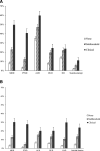Prevalence, risk correlates, and health comorbidities of insomnia in US military veterans: results from the 2019-2020 National Health and Resilience in Veterans Study
- PMID: 33656983
- PMCID: PMC8314657
- DOI: 10.5664/jcsm.9182
Prevalence, risk correlates, and health comorbidities of insomnia in US military veterans: results from the 2019-2020 National Health and Resilience in Veterans Study
Abstract
Study objectives: Veterans experience high levels of trauma, psychiatric, and medical conditions that may increase their risk for insomnia. To date, however, no known study has examined the prevalence, risk correlates, and comorbidities of insomnia in a nationally representative sample of veterans.
Methods: A nationally representative sample of 4,069 US military veterans completed a survey assessing insomnia severity; military, trauma, medical, and psychiatric histories; and health and psychosocial functioning. Multivariable analyses examined the association between insomnia severity, psychiatric and medical comorbidities, suicidality, and functioning.
Results: A total of 11.4% of veterans screened positive for clinical insomnia and 26.0% for subthreshold insomnia. Greater age and retirement were associated with a lower likelihood of insomnia. Adverse childhood experiences, traumatic life events, lower education and income were associated with greater risk for insomnia. A "dose-response" association was observed for health comorbidities, with increasing levels of insomnia associated with elevated odds of psychiatric and medical conditions (clinical vs no insomnia odds ratio = 1.8-13.4) and greater reductions in health and psychosocial functioning (clinical vs no insomnia Cohen's d = 0.2-0.4). The prevalence of current suicidal ideation was 3-5 times higher in veterans with clinical and subthreshold insomnia relative to those without insomnia (23.9% and 13.6% vs 4.5%, respectively).
Conclusions: Nearly 2 in 5 US veterans experience clinical or subthreshold insomnia, which is associated with substantial health burden and independent risk for suicidal ideation. Results underscore the importance of assessment, monitoring, and treatment of insomnia in veterans as they transition from the military.
Keywords: anxiety; insomnia; posttraumatic stress disorder; trauma; veterans.
© 2021 American Academy of Sleep Medicine.
Conflict of interest statement
All authors have seen and approved the final version of this manuscript. The National Health and Resilience in Veterans Study was funded by the US Department of Veterans Affairs National Center for Posttraumatic Stress Disorder. The authors report no conflicts of interest.
Figures

References
-
- American Psychiatric Association . Diagnostic and Statistical Manual of Mental Disorders . 5th ed. Arlington, VA: : American Psychiatric Association; ; 2013. .
Publication types
MeSH terms
LinkOut - more resources
Full Text Sources
Other Literature Sources
Medical

